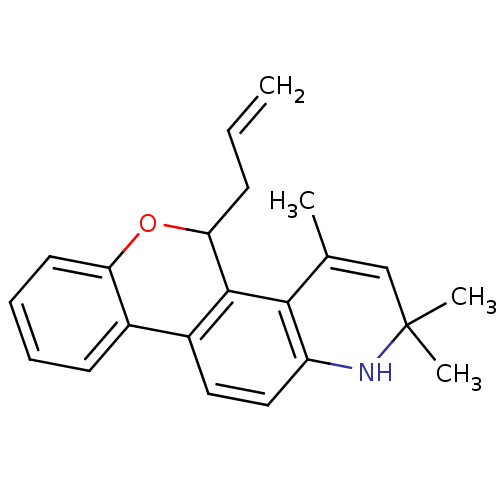BDBM50072707 5-Allyl-2,2,4-trimethyl-2,5-dihydro-1H-6-oxa-1-aza-chrysene::CHEMBL8639
SMILES CC1=CC(C)(C)Nc2ccc3-c4ccccc4OC(CC=C)c3c12
InChI Key InChIKey=BQFHIOXHOTZDCT-UHFFFAOYSA-N
Activity Spreadsheet -- Enzyme Inhibition Constant Data from BindingDB
 Found 10 hits for monomerid = 50072707
Found 10 hits for monomerid = 50072707
Affinity DataKi: 4.80nMAssay Description:Binding affinity was determined against hPR-A (human progesterone receptor) using progesterone radioligand in competitive binding assayMore data for this Ligand-Target Pair
Affinity DataKi: 34nMAssay Description:Binding affinity towards human glucocorticoid receptor (GR) was determined using [3H]-Dexamethasone as radioligand in SF-1 cellsMore data for this Ligand-Target Pair
Affinity DataKi: 36nMAssay Description:Displacement of [3H]-progesterone from human Progesterone receptor AMore data for this Ligand-Target Pair
Affinity DataKi: 889nMAssay Description:Displacement of Dexamethasone from human glucocorticoid receptorMore data for this Ligand-Target Pair
Affinity DataKi: >1.00E+3nMAssay Description:Displacement of DHT from human androgen receptorMore data for this Ligand-Target Pair
Affinity DataKi: >5.00E+3nMAssay Description:Binding affinity towards testosterone receptorMore data for this Ligand-Target Pair
Affinity DataEC50: >300nMAssay Description:Binding affinity towards aldosterone receptor (Mineralocorticoid receptor)More data for this Ligand-Target Pair
Affinity DataEC50: 561nMAssay Description:Antagonist activity against hPR (human progesterone receptor) compared to that of progesterone (100%)More data for this Ligand-Target Pair
Affinity DataEC50: 9nMAssay Description:Agonist activity was determined against hPR (human progesterone receptor) compared to that of progesterone (100%)More data for this Ligand-Target Pair
Affinity DataEC50: 350nMAssay Description:Binding affinity towards aldosterone receptor (Mineralocorticoid receptor)More data for this Ligand-Target Pair
